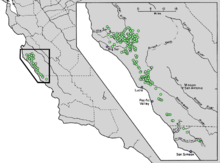Awn fir
| Awn fir | ||||||||||||
|---|---|---|---|---|---|---|---|---|---|---|---|---|

Awn Fir ( Abies bracteata ) |
||||||||||||
| Systematics | ||||||||||||
|
||||||||||||
| Scientific name | ||||||||||||
| Abies bracteata | ||||||||||||
| ( D.Don. ) Poit. |
The awn fir ( Abies bracteata ), also known as the Santa Lucia fir , is a species of the fir genus ( Abies ) in the pine family (Pinaceae). It only grows in the Santa Lucia Mountains on the California coast.
description
Vegetative characteristics
The awn fir is an evergreen tree that can reach heights of growth of 12 to 30, rarely up to 50 meters, and a diameter of up to 1 meter at chest height . The pointed crown is formed by short, slightly drooping branches that extend horizontally from the trunk. The bark of the branches is usually smooth, but can also have a light hairiness and its color can vary between shiny red-brown, a purple green or a simple brown. Young trees have smooth, thin, light red-brown colored bark. In older trees, this bark tears open and a flaky bark is created . The seedlings constitute about seven cotyledons ( cotyledons off).
With a size of 10 to 20 centimeters, the egg-shaped to spindle-shaped buds are yellowish-brown in color, tapered to a point and free of resin. The needles are arranged in two rows or spirals on the branches and spread a pungent odor. The twisted, stiff and pointed needles at their base are between 2.5 and 6 centimeters long and 2.5 to 3 millimeters wide. The top of the needle is dark green in color. On the underside of the needle there are two white stoma bands, each of which has eight to ten rows of stomata.
Generative characteristics
The awn fir is single-sexed ( monoecious ). The flowering time is at the beginning of May. The pale yellowish to yellowish-greenish female cones are 5 to 7 inches long and 2 to 3 inches thick. The egg-shaped, stalked cones are egg-shaped with a length of 6 to 14 centimeters and a diameter of 4 to 5.5 centimeters. When ripe at the end of August to October, they are purple-brown to purple-brown in color. The shiny red-brown seeds are around 5 millimeters long and have 8 to 11 millimeters long wings.
Distribution and location
The awn fir occurs only on a coastal strip in the Santa Lucia Mountains in California . This stretch of coast is located in the Los Padres National Forest . One finds Abies bracteata at altitudes from 180 to 1570 meters.
Abies bracteata is a species of tree of the Mediterranean climate . Depending on the location, the annual rainfall is between 500 and 1300 mm. The species is found both in damp ravines and on rocky slopes.
Mixed stands are often formed with the Coulter pine ( Pinus coulteri ), the yellow pine ( Pinus ponderosa ), the Douglas fir ( Pseudotsuga menziesii ) and Quercus chrysolepis .
use
In the past, the fragrant resin was used as a substitute for incense .
Systematics
The first description was made of this kind in 1836 under the name Pinus bracteata by David Don in Transactions of the Linnean Society of London , Volume 17, p 443. Pierre Antoine Poiteau she set in 1845 in Revue Horticole ... , sér. 2, volume 4, p. 7 under the name Abies bracteata into the genus Abies . The awn fir is allocated within the genus of firs ( Abies ) as the only species of the Bracteatae section .
Synonyms for Abies bracteata (D.Don) Poit. are: Abies venusta coffin. , Abies venusta (Douglas) K. Koch , Pinus bracteata (D.Don) , Pinus venusta Douglas , Abies religiosa sensu Hook. & Arn. , Sequoia gigantea Endl. non (Lindl.) Decne. and Picea bracteata (D.Don) Loud.
Hazard and protection
The awn fir is classified as "low endangered" in the IUCN Red List . The IUCN points out that protection of Abies bracteata is recommended and that a new assessment of the risk is necessary. The reason given for the low classification is that the range of the species is larger than originally assumed.
swell
- Christopher J. Earle: Abies bracteata. In: The Gymnosperm Database. May 22, 2011, accessed on October 24, 2011 (English, section description and systematics).
Individual evidence
- ↑ Entry in GRIN , accessed on December 18, 2010.
- ↑ Rafaël Govaerts (ed.): Abies. In: World Checklist of Selected Plant Families (WCSP) - The Board of Trustees of the Royal Botanic Gardens, Kew . Retrieved April 3, 2019.
- ↑ Abies bracteata in the endangered Red List species the IUCN 2006. Posted by: Conifer Specialist Group, 1998. Accessed August 24 of 2010.



